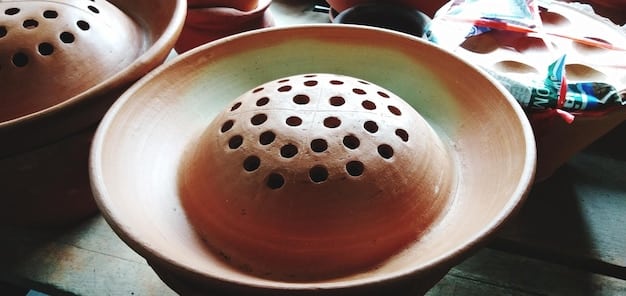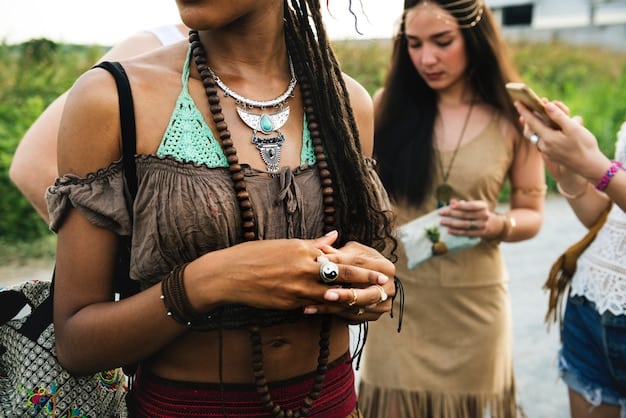Indigenous Tourism in the US: Your 2025 Guide to Cultural Immersion

Indigenous tourism in the US in 2025 offers authentic and respectful cultural experiences, supporting tribal communities through sustainable travel, and providing unique insights into Native American heritage and traditions.
Embark on a journey of discovery and respect with our Indigenous Tourism in the US: A Respectful Guide to Cultural Immersion in 2025. This guide is your passport to understanding and experiencing the rich heritage of Native American tribes through authentic and sustainable tourism.
Why Indigenous Tourism Matters
Indigenous tourism goes beyond sightseeing; it’s about connecting with the heart and soul of a culture. It offers a unique opportunity to learn directly from Indigenous communities, supporting their economic independence and preserving their cultural heritage. By choosing Indigenous-led experiences, travelers contribute to the sustainability and revitalization of these communities.
In recent years, there has been a growing awareness of the importance of responsible travel. People are increasingly seeking authentic and meaningful experiences that benefit local communities. Indigenous tourism aligns perfectly with this trend, providing travelers with a chance to engage with cultures in a respectful and mutually beneficial way.

Economic Empowerment
One of the key benefits of Indigenous tourism is its potential for economic empowerment. When tourists spend money directly with Indigenous-owned businesses and organizations, it helps to create jobs, support local economies, and foster entrepreneurship. These economic opportunities enable communities to invest in education, healthcare, and infrastructure, improving the overall quality of life.
Furthermore, Indigenous tourism can help to diversify local economies, reducing dependence on industries that may be environmentally unsustainable. By promoting cultural tourism, communities can create a more resilient and sustainable economic base that benefits both present and future generations.
Cultural Preservation
Indigenous tourism plays a vital role in preserving cultural heritage. By sharing their traditions, stories, and knowledge with visitors, Indigenous communities can ensure that their cultural heritage is not lost or forgotten. This can include traditional dances, music, storytelling, crafts, and culinary traditions.
Moreover, Indigenous tourism can help to revitalize traditional languages and practices. As more people become interested in learning about Indigenous cultures, there is a greater incentive to maintain and promote these traditions. This can help to strengthen cultural identity and foster a sense of pride within the community.
- 🌍 Supports Indigenous-owned businesses
- 🛡️ Preserves cultural heritage
- 🤝 Fosters cross-cultural understanding
By understanding the importance of Indigenous tourism, travelers can make informed choices that support sustainable and responsible travel. This not only enriches their own experiences but also contributes to the well-being of Indigenous communities and the preservation of their cultural heritage.
Planning Your Respectful Indigenous Tourism Trip in 2025
Planning a trip that respects Indigenous cultures requires careful consideration. It’s about more than just booking a tour; it’s about engaging with communities respectfully and learning about their history and traditions. Understanding the protocols and customs of the community you’re visiting is essential for a meaningful and responsible experience.
Start by researching the Indigenous nations whose lands you plan to visit. Learn about their history, culture, and current issues. This knowledge will help you to appreciate their contributions and challenges and to engage with them in a more informed and respectful way.

Researching Indigenous Nations
Before your trip, take the time to research the specific Indigenous nations whose lands you’ll be visiting. Each nation has its own unique history, culture, and traditions. Learning about these differences will help you to appreciate the diversity of Indigenous cultures and to avoid making generalizations or stereotypes.
Look for online resources, books, and documentaries that provide accurate and respectful information about Indigenous nations. Be sure to consult multiple sources and to critically evaluate the information you find. Consider contacting the tribal government or cultural center to learn more about their history and culture.
Choosing Ethical Tours and Accommodations
When planning your trip, choose tour operators and accommodations that are Indigenous-owned or that partner with Indigenous communities. These businesses are more likely to prioritize cultural sensitivity and to ensure that tourism benefits the local community.
Look for tour operators that offer authentic and educational experiences, rather than superficial or exploitative ones. Ask about the training and experience of the guides and the steps they take to ensure cultural sensitivity. Choose accommodations that are environmentally sustainable and that respect local customs and traditions.
- ✅ Research Indigenous nations beforehand
- 🏨 Choose Indigenous-owned accommodations
- 🗣️ Respect local customs and traditions
With careful planning, you can create a trip that is both enriching and responsible. By engaging with Indigenous communities in a respectful and meaningful way, you can contribute to their economic empowerment and cultural preservation, while also gaining a deeper understanding of their history and traditions. This approach ensures that your journey is not only memorable but also beneficial to the communities you visit.
Best Indigenous Cultural Sites to Visit in 2025
The United States is home to a wealth of Indigenous cultural sites, each offering unique insights into the history and traditions of Native American tribes. From ancient ruins to vibrant cultural centers, these sites provide opportunities to learn, engage, and connect with Indigenous cultures in a meaningful way. When visiting these sites, remember to be respectful and mindful of their cultural significance.
Consider visiting sites like Mesa Verde National Park in Colorado, which showcases the ancient cliff dwellings of the Ancestral Puebloans, or the Navajo Nation in Arizona, where you can explore the stunning landscapes of Monument Valley and Canyon de Chelly. These sites not only offer breathtaking scenery but also provide opportunities to learn about the history and culture of the Navajo people.
Mesa Verde National Park, Colorado
Mesa Verde National Park is a UNESCO World Heritage Site that preserves the ancient cliff dwellings of the Ancestral Puebloans. These dwellings, built between the 6th and 12th centuries CE, are some of the best-preserved archaeological sites in the United States. Visitors can explore the dwellings on guided tours, learning about the history and culture of the Ancestral Puebloans.
When visiting Mesa Verde, remember to be respectful of the site and its cultural significance. Follow the instructions of the guides, stay on designated trails, and avoid touching or disturbing the ruins. By treating the site with respect, you can help to preserve it for future generations.
Navajo Nation, Arizona
The Navajo Nation is the largest Native American territory in the United States, encompassing parts of Arizona, New Mexico, and Utah. The nation is home to stunning landscapes, including Monument Valley, Canyon de Chelly, and the Grand Canyon. Visitors can explore these landscapes on guided tours led by Navajo guides, learning about the history and culture of the Navajo people.
When visiting the Navajo Nation, be sure to respect Navajo customs and traditions. Ask permission before taking photographs, and avoid entering restricted areas. Support Navajo-owned businesses and organizations, and be mindful of your impact on the environment. By engaging with the Navajo people in a respectful and responsible way, you can contribute to their economic empowerment and cultural preservation.
- 🏞️ Mesa Verde: Explore ancient cliff dwellings
- 🏜️ Navajo Nation: Discover stunning landscapes
- 🏛️ Cultural Centers: Engage with tribal histories
Exploring these cultural sites offers a profound way to deepen your understanding and appreciation of Indigenous heritage. By planning your visit with respect and engaging with local communities, you ensure a meaningful and enriching experience. Such journeys not only broaden your perspective but also contribute to the preservation and celebration of Indigenous cultures for years to come.
Supporting Indigenous Businesses and Artisans
One of the most direct ways to support Indigenous communities is by purchasing goods and services from Indigenous-owned businesses and artisans. These businesses often showcase traditional crafts, art, and culinary traditions, providing visitors with authentic and unique souvenirs. By buying directly from Indigenous businesses, you can help to create economic opportunities and support cultural preservation.
Look for businesses that are certified as Indigenous-owned or that are members of Indigenous business associations. These certifications and associations can help to ensure that the businesses are genuinely Indigenous-owned and that they adhere to ethical and sustainable business practices.
Authentic Crafts and Art
Indigenous artisans create a wide range of crafts and art, including pottery, jewelry, textiles, and carvings. These items often reflect traditional designs and motifs, and they are made using techniques passed down through generations. When purchasing crafts and art, be sure to buy from reputable sources that support fair trade practices. This will help to ensure that the artisans are paid fairly for their work and that their cultural heritage is respected.
Consider visiting Indigenous art markets and cultural centers, where you can meet the artisans and learn about their craft. These interactions can provide valuable insights into the creative process and the cultural significance of the art.
Culinary Experiences
Indigenous cuisine is a rich and diverse culinary tradition that reflects the unique landscapes and resources of Native American territories. Many Indigenous-owned restaurants and food vendors offer traditional dishes made with locally sourced ingredients. By trying Indigenous cuisine, you can support local farmers and food producers and learn about the culinary traditions of Native American tribes.
Look for restaurants that offer traditional dishes made with ingredients like bison, wild rice, and corn. Be sure to ask about the history and cultural significance of the dishes you try. This will help you to appreciate the culinary traditions of Native American tribes and to support their economic empowerment.
- 🛍️ Buy directly from Indigenous artisans
- 🍽️ Support Indigenous-owned restaurants
- 🤝 Ensure fair trade practices
Supporting Indigenous businesses and artisans is not just about making a purchase; it’s about investing in a community’s future. Your choices can help sustain cultural practices, support livelihoods, and promote economic independence. Be a conscious consumer and choose to support Indigenous businesses whenever possible, ensuring that your visit leaves a positive impact.
Respecting Cultural Protocols and Etiquette
Showing respect for Indigenous cultures involves more than just avoiding offensive behavior; it requires an active effort to understand and observe cultural protocols and etiquette. These protocols vary from tribe to tribe, but there are some general guidelines that visitors should follow. By showing respect for cultural protocols, you can demonstrate your appreciation for Indigenous cultures and build positive relationships with local communities.
Always ask permission before taking photographs of people, ceremonies, or sacred sites. Be mindful of your body language and avoid making assumptions or stereotypes. Listen respectfully to the stories and teachings of Indigenous elders and knowledge keepers.
Photography and Filming
Photography and filming can be sensitive issues in Indigenous communities. Some tribes have strict rules about photographing ceremonies or sacred sites, while others may require permission before photographing individuals. Always ask for permission before taking photographs, and respect the wishes of the community. If you are unsure about the rules, it is always best to err on the side of caution and avoid taking photographs altogether.
Be aware that some ceremonies are considered sacred and are not open to the public. Respect the privacy of these ceremonies and avoid attempting to photograph or film them without permission.
Interactions with Elders and Knowledge Keepers
Elders and knowledge keepers are highly respected members of Indigenous communities. They are the keepers of traditional knowledge and wisdom, and they play a vital role in preserving cultural heritage. When interacting with elders and knowledge keepers, be sure to show respect and deference. Listen attentively to their stories and teachings, and avoid interrupting or challenging them.
Offer gifts or donations as a sign of respect, and express your gratitude for their time and knowledge. Be mindful of your body language and avoid making assumptions or stereotypes. By showing respect for elders and knowledge keepers, you can demonstrate your appreciation for Indigenous cultures and build positive relationships with local communities.
- 📷 Always ask permission before photographing
- 👂 Listen respectfully to elders
- 🚫 Avoid stereotypes and assumptions
Respecting cultural protocols and etiquette is key to fostering positive relationships and ensuring meaningful interactions during your visit. Take the time to learn about the specific customs of the community you are visiting, and always act with humility and respect. Your efforts will contribute to creating a welcoming and understanding environment for both visitors and hosts.
Sustainable Practices in Indigenous Tourism
Sustainability is an essential aspect of responsible Indigenous tourism. It involves minimizing the environmental impact of tourism, supporting local economies, and preserving cultural heritage. By adopting sustainable practices, Indigenous communities can ensure that tourism benefits both present and future generations. When planning your trip, look for businesses and organizations that prioritize sustainability and ethical practices.
Support businesses that use renewable energy, recycle waste, and conserve water. Choose tour operators that offer eco-friendly tours and activities, and be mindful of your impact on the environment. By adopting sustainable practices, you can help to protect the natural resources and cultural heritage of Indigenous communities.
Environmental Stewardship
Indigenous communities have a deep connection to the land and a long history of environmental stewardship. Many Indigenous cultures view the natural world as sacred and believe that humans have a responsibility to protect it. When visiting Indigenous territories, be mindful of your impact on the environment and adopt sustainable practices.
Avoid littering, stay on designated trails, and conserve water and energy. Support businesses that use sustainable farming practices and that protect biodiversity. By showing respect for the environment, you can demonstrate your support for Indigenous values and contribute to the preservation of natural resources.
Community Engagement
Sustainable tourism is about more than just protecting the environment; it also involves engaging with local communities and supporting their economic and social well-being. Look for opportunities to volunteer your time, donate to local charities, or participate in community events. By engaging with local communities, you can learn about their culture and traditions and contribute to their economic empowerment and social development.
Support businesses that hire local employees, pay fair wages, and provide opportunities for training and advancement. Choose accommodations that are owned and operated by local residents and that support local businesses. By engaging with local communities, you can help to create a more equitable and sustainable tourism industry.
- 🌿 Minimize environmental impact
- ♻️ Support businesses with sustainable practices
- 🤝 Engage with local communities
Adopting sustainable practices in Indigenous tourism ensures that your visit contributes positively to the preservation of natural resources and the well-being of local communities. By being mindful of your impact and supporting ethical businesses, you help create a tourism model that respects both the environment and the cultural heritage of Indigenous peoples.
| Key Aspect | Brief Description |
|---|---|
| 🌍 Cultural Respect | Engage respectfully with Indigenous customs and traditions. |
| 🤝 Economic Support | Support Indigenous-owned businesses and artisans. |
| 🌿 Sustainability | Practice environmental stewardship and support sustainable tourism. |
| 📚 Education | Learn about the history and culture of the Indigenous nations you visit. |
Frequently Asked Questions
▼
Indigenous tourism involves visiting and learning about the cultures, histories, and traditions of Native American tribes, often through Indigenous-owned businesses and organizations. It is about respecting and supporting these communities while experiencing their unique heritage.
▼
Ensure your trip is respectful by researching the Indigenous nations you plan to visit, choosing Indigenous-owned tours and accommodations, respecting cultural protocols, and supporting local businesses. Always ask permission before photographing or participating in ceremonies.
▼
Recommended cultural sites include Mesa Verde National Park in Colorado, showcasing Ancestral Puebloan cliff dwellings, and the Navajo Nation in Arizona, where you can explore Monument Valley and Canyon de Chelly. These sites offer unique insights into Indigenous history and culture.
▼
Support Indigenous businesses by purchasing crafts and art directly from Indigenous artisans, dining at Indigenous-owned restaurants, and choosing accommodations that are owned or partner with Indigenous communities. Look for certifications that verify Indigenous ownership.
▼
Follow sustainable practices by minimizing your environmental impact, supporting businesses that use renewable energy and conserve resources, and participating in community engagement activities. Respect the land and water, and be mindful of your consumption.
Conclusion
As you plan your journey into the world of Indigenous Tourism in the US in 2025, remember that respect, understanding, and support are paramount. By engaging thoughtfully with Indigenous cultures, you’ll not only enrich your own travel experience but also contribute to the preservation and prosperity of these vibrant communities. Embrace the opportunity to learn, connect, and make a positive impact on your next adventure.





